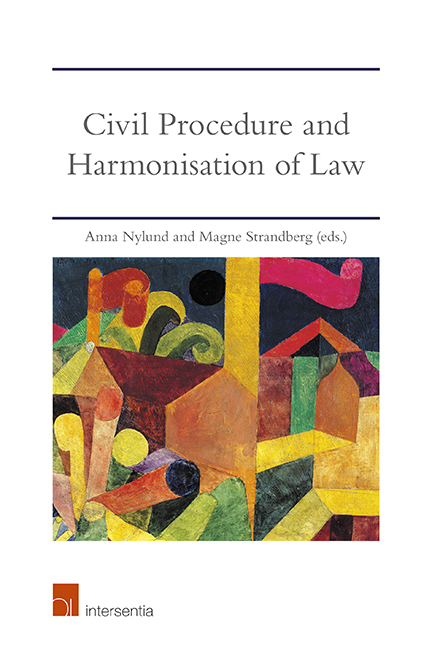Book contents
- Frontmatter
- Preface
- Contents
- List of Contributors
- List of Abbreviations
- Introduction
- EU Civil Justice at the Harmonisation Crossroads?
- The ELI-UNIDROIT Project: An Introduction and an English Perspective
- Europeanisation of Civil Procedure: Overcoming Follow-Up Fragmentation through Bottom-Up Harmonisation?
- Harmonisation or Fragmentation of National Law? An East Nordic Perspective
- An Examination of the Influence of European Union Law on English Civil Procedure
- The EU's Influence on Norwegian Civil Procedure through National Substantive Law
- Consumer Protection and EU-Driven Judicial Activism in the Netherlands
- The Role of the Judge in Consumer Cases – A German Perspective
- Ex Officio Application of the Unfair Terms Directive Cases against Consumers: A Swedish Perspective
- Ex Officio Application of EU Consumer Protection Law in Norwegian Courts
- Maintenance and Multi-Level Harmonisation: A European Union Perspective
- Family Maintenance and Multi-Speed Integration: A Norwegian Perspective
- Conclusions on Civil Procedure and Harmonisation of Law
- About the Editors
Harmonisation or Fragmentation of National Law? An East Nordic Perspective
Published online by Cambridge University Press: 30 March 2019
- Frontmatter
- Preface
- Contents
- List of Contributors
- List of Abbreviations
- Introduction
- EU Civil Justice at the Harmonisation Crossroads?
- The ELI-UNIDROIT Project: An Introduction and an English Perspective
- Europeanisation of Civil Procedure: Overcoming Follow-Up Fragmentation through Bottom-Up Harmonisation?
- Harmonisation or Fragmentation of National Law? An East Nordic Perspective
- An Examination of the Influence of European Union Law on English Civil Procedure
- The EU's Influence on Norwegian Civil Procedure through National Substantive Law
- Consumer Protection and EU-Driven Judicial Activism in the Netherlands
- The Role of the Judge in Consumer Cases – A German Perspective
- Ex Officio Application of the Unfair Terms Directive Cases against Consumers: A Swedish Perspective
- Ex Officio Application of EU Consumer Protection Law in Norwegian Courts
- Maintenance and Multi-Level Harmonisation: A European Union Perspective
- Family Maintenance and Multi-Speed Integration: A Norwegian Perspective
- Conclusions on Civil Procedure and Harmonisation of Law
- About the Editors
Summary
TREATY-BASED STARTING POINT
Judicial co-operation in civil matters simply means closer co-operation between Member States in order to minimise obstacles arising from the existence of varying legal systems. The current definition and objectives of judicial co-operation in civil matters are, however, a result of historical development. Judicial co-operation was not one of the objectives of the European Community when the founding treaty was adopted. It was first officially included within the EU's sphere of activity by the Treaty of Maastricht. Then, the Treaty of Amsterdam brought judicial co-operation in civil matters within the Community sphere, transferring it from the Treaty on European Union to the Treaty establishing the European Community.
Initially, governed by international conventions, judicial co-operation in civil matters was included in the Maastricht Treaty as a ‘matter of common interest’, and subsequently in the Treaty of Amsterdam, which places judicial co-operation in civil matters on the Community level by associating it with the free movement of persons, which is a milestone in this development. In theory and in practice, this constitutes a great leap from the common interest to free movement. As a matter of fact, free movement requires far greater harmonisation and co-ordination than that dictated by a common interest. Therefore, the change between the Maastricht Treaty and the Treaty of Amsterdam was a very significant one in terms of harmonisation, and meant that even procedural law has come to be covered by common EU law. The free movement of persons is a core principle of EU law, and is also the one with which the general public is most familiar. To introduce co-operation in civil matters into the principle of free movement is not only radical, but revolutionary. Let's see how successful this introduction has been, especially in the East Nordic countries, namely Finland and Sweden.
East Nordic countries are comparable because of their common history and similar codes for judicial procedure. Finland was a part of the Kingdom of Sweden from the thirteenth century until 1809, when the vast majority of the Finnish-speaking areas of Sweden were ceded to the Russian Empire (excluding the areas of modern-day northern Sweden), making this area autonomous.
- Type
- Chapter
- Information
- Civil Procedure and Harmonisation of LawThe Dynamics of EU and International Treaties, pp. 77 - 98Publisher: IntersentiaPrint publication year: 2019
- 1
- Cited by



